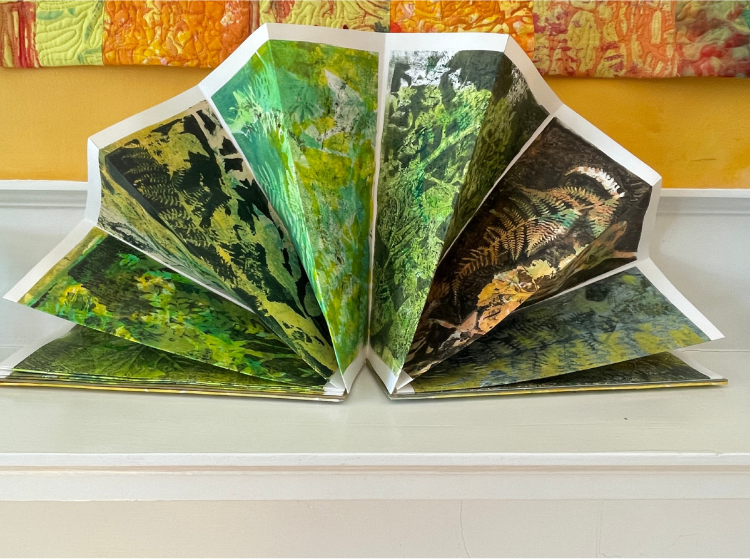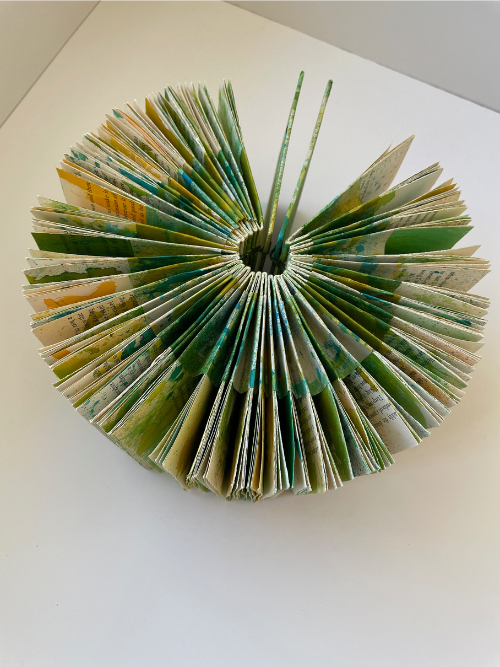
Gelliprinting with Botanicals 1M24

This workshop will teach the basics of gelliprinting using botanicals (plants, weeds and flowers). Join us to learn several different ways to make botanical prints. We will talk about the different kinds of paints that are used in printing, colors and color mixing, and the paint characteristics that allow for layering, an important concept for gelliprinting printing.
At the end of the workshop, students will have learned basic information about gelliprinting including the concepts of main and ghost prints, the use of a brayer, characteristics of acrylic paint, and how to make botanical prints. We will also talk about the different kinds of paper that can be used for gelliprinting and discuss different ways that these prints can be used.
Students will begin the workshop by gathering plants and weeds in the vicinity of the Eliot School. From there, Diane will demonstrate basic concepts, talk about color and paper and layering. In the afternoon, we will make many gelliprints using the materials they gathered in the morning and the information learned in the first part of the workshop.
Diane will be teaching a workshop the following Saturday July 20 called Folding and Unfolding: An Introduction to Folded Book Structures and Artists' Books. The printed paper from this workshop can be used in her following workshop to create book structures.
Diane Franklin

Diane Franklin is an artist, teacher and writer living and working in Jamaica Plain. She makes large wall pieces from fabric and/or paper, using a variety of surface design techniques. Starting with white fabric or paper, she uses shibori dyeing, screen printing, painting,rusting, gelli printing , etc. to transform the surface of her materials. She then combines these materials into abstract compositions. Diane has exhibited her work in numerous group and solo exhibitions throughout the United States and has won awards for several of her pieces. For the past few years, Diane has also made a number of artist books and collages, using her own photographs or printed papers. Diane has also written articles about fiber related topics for Fiber Art Now and Fibre Arts Take Two. She is also the author of Dyeing Alchemy, a primer and workbook about Procion dyeing.
Her fiber pieces can be seen on her website, www.dianefranklinart.com, and many of her books and collages can be viewed on her Instagram account: https://www.instagram.com/diane.franklin/
Most of the tools and materials you will need for this workshop will be provided by the Eliot School.
You will need to bring:
- 3-4 small tubes of acrylic paint. Good, not-too-expensive brands are Liquitex, Amsterdam, Dick Blick or Utrecht acrylic paints. Choose 3 colors you'd like to use for botanical printing. These should be a mix of transparent and opaque paints, preferably 2 transparent and 1 opaque. The opaque paint should be a dark color, preferably black though another dark color is okay. You should include at least one light color in your selection. If you already have acrylic paints, you can bring more than 3 colors. You can choose realistic plant colors or any other colors you fancy.
- Any interesting papers you might want to print on in addition to the white papers that will be provided to you. These can be junk mail, papers you've drawn on, existing prints, sheet music, etc.
- Some pieces of lightweight cardboard. Include some cardboard packaging and some recycled cardboard such as cereal boxes or any other lightweight packaging. such as small soap boxes or other little boxes in which household items are packaged. Also include one or two manila envelopes. The envelopes can be already used and have labels or stamps on them.
- A bag or bucket in which to put the plant materials you pick.
- An apron or smock to protect your clothes and lightweight vinyl gloves if you're worried about getting acrylic paint on your hands.
- A pencil with an eraser and some scissors
Also, please bring lunch, snacks and water.
